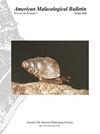两性生殖淡水蜗牛Planorbella trivolvis白化病的遗传基础
IF 0.4
4区 生物学
Q4 MARINE & FRESHWATER BIOLOGY
引用次数: 6
摘要
摘要:在许多物种中,有色素个体和无色素个体之间的差异是由于单隐性孟德尔基因造成的。我们已经证明,淡水雌雄同体蜗牛Planorbella trivolvis(Say,1817)也是如此,并建立了一个与野生种群具有相似遗传背景的白化种群,因此色素沉着可以作为一种可见的遗传标记,以更好地了解这些软体动物的生殖生物学。我们在来自近交系实验室菌株的白化(A)个体和从自然种群中移除一代的色素沉着(P)个体之间进行了孟德尔杂交,并评估了交配后立即和11周后收集的卵子中后代的色素沉着。亲本、F1和F2代以及与纯育种白化病的回交的结果与孟德尔单基因遗传模式一致。因为我们从未观察到任何白化蜗牛与色素精子捐献者交配后产生的白化后代,我们也证实了在P.trivolvis中自拍是罕见的。在这种不寻常的雌雄同体蜗牛身上,一个几乎没有自我受精的简单的非侵入性亲子标记将有助于实验了解其生殖生物学,并提供更完整的雌雄交配策略。本文章由计算机程序翻译,如有差异,请以英文原文为准。
The Genetic Basis of Albinism in the Hermaphroditic Freshwater Snail Planorbella trivolvis
Abstract:
In many species, the difference between pigmented and non-pigmented individuals is due to a single recessive Mendelian gene. We have demonstrated that this is also the case in the freshwater hermaphroditic snail, Planorbella trivolvis (Say, 1817), and established an albino population with comparable genetic background to a wild population so that pigmentation can be used as a visible genetic marker to better understand the reproductive biology of these mollusks. We carried out Mendelian crosses between albino (A) individuals from an inbred laboratory strain and pigmented (P) individuals one generation removed from a natural population and assessed pigmentation of progeny from eggs collected immediately after mating and 11 weeks later. Results of parental, F1, and F2 generations and backcrosses to pure-breeding albinos were consistent with a Mendelian single gene inheritance pattern. Because we never observed albino progeny from any albino snails mated to pigmented sperm donors, we also confirmed that selfing is rare in P. trivolvis. A simple non-invasive paternity marker in this unusual hermaphrodite snail that displays almost no self-fertilization will facilitate experiments to understand its reproductive biology and provide a more complete picture of hermaphrodite mating strategies.
求助全文
通过发布文献求助,成功后即可免费获取论文全文。
去求助
来源期刊
CiteScore
1.00
自引率
40.00%
发文量
1
审稿时长
>12 weeks
期刊介绍:
The American Malacological Bulletin serves as an outlet for reporting notable contributions in malacological research. Manuscripts concerning any aspect of original, unpublished research,important short reports, and detailed reviews dealing with molluscs will be considered for publication. Recent issues have included AMS symposia, independent papers, research notes,and book reviews. All published research articles in this journal have undergone rigorous peer review, based on initial editor screening and anonymous reviewing by independent expertreferees. AMS symposium papers have undergone peer review by symposium organizer, symposium participants, and independent referees.

 求助内容:
求助内容: 应助结果提醒方式:
应助结果提醒方式:


